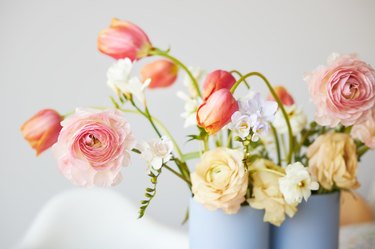
The ranunculus plant (Ranunculus spp.) offers spring blooms and grows from bulbs or tuberous roots. Depending on the species, the flowers grow in U.S. Department of Agriculture plant hardiness zones 3 to 10. Be sure to check the specific zones for the species you select. The state of Texas has regions that are categorized as hardiness zones 6 to 9, so you can grow many species in the state.
How to Plant Ranunculus Bulbs
Video of the Day
Select a location for planting ranunculus bulbs. They need well-drained soil to keep the roots from rotting. Do ranunculus need full sun? They prefer full sun, but they can also thrive in part shade.
Video of the Day
It is important to know when to plant ranunculus bulbs to enjoy the best blooms. In most parts of Texas, you can put the bulbs in the ground in the fall. Place the bulbs in the ground about 2 inches deep and 4 to 6 inches apart. The spiked portion of the roots should point downward. Water the bulbs and cover the soil with mulch to maintain soil moisture and heat.
In zones 6 and 7, it is best to wait until late winter after the last frost. Soak the bulbs for three or four hours before planting. If you are having a particularly cold or late winter, consider starting the bulbs indoors in small pots or trays. Then, transplant the bulbs to your garden when temperatures warm.
How to Grow Ranunculus
Growing ranunculus is a fun endeavor, as these beautiful blooms are fairly low maintenance. After planting in the fall, you don't need to do anything else until the shoots appear in the spring. Once they start growing, water regularly when you don't get rain so that the soil stays moist. Enjoy the blooms throughout the spring and consider cutting some flowers to brighten your home.
Are ranunculus perennials? The plant is a perennial but can be grown as an annual if you prefer. If you opt to grow them as a perennial, allow the foliage to die back completely on its own before cutting it to the ground after the plants stop blooming. This is important to ensure that the bulbs have the nutrients they need to bloom again next year.
Once the plants are dormant, you can stop irrigating them. In zones 8 to 10, you can typically leave the bulbs in the ground over the winter. However, in zones 6 and 7, lift the bulbs after cutting back the foliage and store them in a dry location for the winter months.
Growing Tips and Considerations
The tuberous roots only need shallow soil, which makes growing ranunculus in pots an excellent option. The soil in containers may dry out faster than garden soil, so you may need to water them more often. You should not need to make any other adjustments in care.
Make sure you always wear gloves when working with this plant and avoid ingesting any part of the plant. Monitor children and pets to make sure they don't get into the ranunculus. The plant can cause contact dermatitis, blisters, burning and redness of the skin. When ingested, it can cause abdominal pain, bloody diarrhea, burning of the mouth, hypersalivation and vomiting. Other symptoms may include anorexia, depression and a wobbly gait.